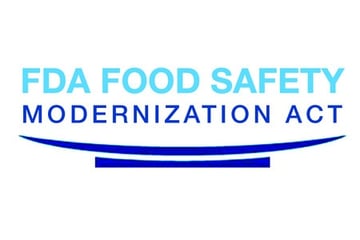The Food Safety Modernization Act (FSMA) works to prevent foodborne illnesses in the United States by providing the FDA with more regulatory power. It can be categorized into seven rules:
- Produce safety
- The Foreign Supplier Verification Program (FSVP)
- Sanitary transportation
- Protection against intentional adulteration
- Accredited third-party certification
- Preventive control for human and animal food
- The Voluntary Qualified Importer Program (VQIP)
Every firm regulated by the FDA must develop food safety plans compliant with FSMA. These should be tailored to the company’s unique processes and aim to align with the FDA’s guidelines.
Below, we discuss the components of a FSMA-compliant food safety plan and how to approach creating one.
Components of a FSMA Food Safety Plan
A FSMA food safety plan is essentially an extension of Hazard Analysis and Critical Control Points (HACCP) plans, but it includes additional regulations to address more comprehensive elements of food safety. Any firm in the food industry regulated by the FDA must have a food safety plan even if a HACCP plan is already in place. Similarly, firms should follow the guidelines of FSMA over older precedents.
Listed below are the key elements of a FSMA food safety plan:
General Information
The general information that should be included incorporates facility information, planned reanalysis of the plan at periodic intervals, signatures, recordkeeping, important contacts, and other supporting documents.
Good Manufacturing Practices (GMP)
The GMP portion of the plan must include all previous elements of HARPC and HACCP GMP regulations, but now also explicitly regulates previously non-binding components. First, firm management must ensure proper education and training for employees that manufacture, process, pack, or hold food. This training should include food and employee hygiene and safety. Firms in the food industry must now also address allergen cross-contact. Finally, there is new regulation for firms that deal with human food byproducts used in animal food.
Hazard Analysis & Preventive Controls
A preliminary hazard analysis must be conducted of any regulated food facilities to determine which must have preventive controls. It should seek to identify known or anticipated biological, chemical, and physical hazards. Any identified hazards must then have clearly defined preventive controls in place.
These written preventive controls are required to minimize the potential impact of any food hazards. They can be categorized into process, allergen, sanitation, and supply chain preventive controls.
Process controls seek to mitigate risks from the modification of food products including cooking, refrigeration, and acidification. Critical limits should be defined to understand testing and maintenance parameters. Food allergen controls serve to eliminate allergen cross-contact at any food facility in addition to ensuring allergens are properly labeled on packaged goods. Sanitation controls reduce the presence of environmental pathogens, food allergens, and unsanitary contaminants. Firms should also define recurring sanitary maintenance of food facilities.
Finally, facilities only need supply chain preventive controls if they manage the product’s distribution. A receiving facility, however, must still review any supplier’s preventive controls for applicable hazards. Those that do need supply chain controls should seek to eliminate hazards that can appear during distribution.
Every facility must also monitor hazards, correct them if appropriate, take measures to ensure the hazards will not reappear, and verify that preventive controls are properly maintained. It is imperative that everything be documented.
Recall Plan
If a hazard appears that triggers a preventive control, each facility should have a clearly defined food recall plan. This should include the notification of appropriate parties, including the public, if necessary, effective documentation, and handling of the recalled product.
Record Keeping
Keeping detailed records of all elements of food safety is crucial. This means that every aspect of the food safety plan should be written. Similarly, proper maintenance and certification of elements of the plan should also be recorded.
FSMA Section 204 now establishes additional recordkeeping requirements for certain foods and outlines a list of items on the Food Traceability List that require enhanced traceability recordkeeping due to their high-risk nature. Firms that grow, distribute, manufacture, or sell any of the items on the list, or qualifying products with FTL ingredients, are required to keep additional records for those items.
Ultimately, proper maintenance of records is a good idea for all food products. This can minimize the impact of potential risks, reduce liability, and help to monitor past events.
Ensuring FSMA Compliance
The Food Safety Modernization Act comprehensively aims to improve food safety and mitigate harmful impacts of hazardous food. Food safety and traceability are key components for every firm to properly manage and maintain. The broad scope of this mission can make it difficult for firms without industry-leading food safety and traceability software. Firms should consider partnerships that allow them to operate more efficiently and within FDA regulations.
Now that the FDA published FSMA 204, companies must now begin the process of putting these traceability recordkeeping processes into action.
Request time with one of our experts to discuss key components of the FSMA 204 rule and how your brand can strategically prepare for tech-enabled traceability recordkeeping.
Other posts you might be interested in
View All Posts
Food Industry
7 min read
| April 7, 2023
The Essential Components of a Successful Food Traceability System
Read More
Supplier Compliance
8 min read
| May 31, 2018
In Wake of Romaine Lettuce Recall, FoodLogiQ Shares Thoughts on the Importance of Supply Chain Management and Food Traceability
Read More
Food Safety
6 min read
| August 9, 2016

